I've painted a lot of paperback covers. For each job I get a big thick manuscript. I use the old manuscripts for scratch paper. Once it a while I’ll turn a sheet of paper over to see what’s written on it. Sentences like this jump out at me:
“…Flames from the creature licked at his back. Something crackled around his head, and he realized his hair was on fire…”
For an illustrator like me, a line like that is hard to pass up. So I’ve snipped out a few of the best excerpts and stuck them out of context into the pages of a big blank sketchbook.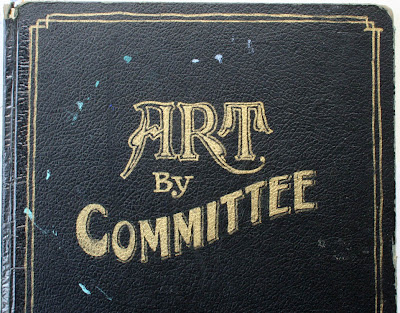
I call the book ART BY COMMITTEE. I bring it to coffee shops when I’m hanging out with other artists. The other artist might be my wife or it might be a couple of notable comic artists, painters, or animators. I can’t reveal their identities—in fact I can’t remember exactly who drew what. And don’t ask me what novel the excerpt came from. I have no clue.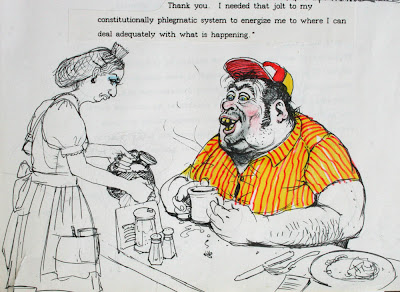
While waiting for the scrambled eggs, we take turns illustrating the scraps of stories. Here’s a sample page. Click to enlarge. If you like this sort of thing, there’s more where it came from.
Viewing: Blog Posts Tagged with: Illustrated Books, Most Recent at Top [Help]
Results 1 - 9 of 9
Blog: Gurney Journey (Login to Add to MyJacketFlap)
JacketFlap tags: Writing, Illustrated Books, Comics/Cartooning, Comics/Cartooning, Illustrated Books, Add a tag
Blog: Gurney Journey (Login to Add to MyJacketFlap)
JacketFlap tags: Pen and Ink, Illustrated Books, Comics/Cartooning, Museum Visits, Add a tag
Last week Jeanette and I visited the Norman Rockwell Museum in Stockbridge, Massachusetts to see the exhibition called “Lit Graphic: The World of the Graphic Novel,” which is on view through May 26.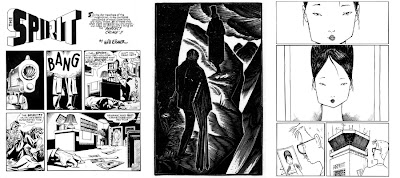 Co-curators Stephanie Plunkett and Martin Mahoney told us that Tom Wolfe invented the term “Lit Graphic” to describe the art form of the contemporary novel-length comic book, which has unfortunately been overlooked by most art museums.
Co-curators Stephanie Plunkett and Martin Mahoney told us that Tom Wolfe invented the term “Lit Graphic” to describe the art form of the contemporary novel-length comic book, which has unfortunately been overlooked by most art museums.
Will Eisner, whose work on the groundbreaking Contract with God is well represented in the show, coined the more familiar term “graphic novel.” Another pioneer was Lynd Ward, who told wordless stories with woodcuts in the 1920s and 1930s. Forty-nine of those delicate images, each separately framed, festoon one wall.
Let me say a word about what is not in the exhibition. There are no French or Japanese comics, no daily or Sunday comic strips, and no Marvel or DC superhero comics. Although most of the works deal with serious, real-world themes, the curators stopped short of exhibiting work that is extremely violent or risqué. But that still leaves a diverse and vital field of talent.
In the room tracing the history of the graphic novels, there are some representative examples by Robert Crumb (including a teenage sketchbook) , but the other two rooms place the emphasis on the contemporary American scene.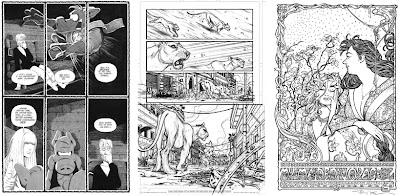 As Mark Wheatley observes, graphic novels are not a genre, but "a language--and it's a visual language." Altogether, there are 146 works by 24 artists, including pages by Peter Kuper, Lauren Weinstein, Harvey Kurtzman, Marc Hempel, Dave Sim, Terry Moore and many others.
As Mark Wheatley observes, graphic novels are not a genre, but "a language--and it's a visual language." Altogether, there are 146 works by 24 artists, including pages by Peter Kuper, Lauren Weinstein, Harvey Kurtzman, Marc Hempel, Dave Sim, Terry Moore and many others.
You can get an online preview of the work and the personalities by viewing the half-dozen mini-documentaries shot on location by producer Jeremy Clowe and recently posted on YouTube:
Part 1: Peter Kuper
Part 2: Marc Hempel
Part 3: Brian Fies
Part 4: Continued
The Rockwell Museum deserves a lot of credit for their pioneering spirit in championing American narrative art in all its forms. In conjunction with the Lit Graphic show, the museum is hosting a student graphic novel contest, inviting high schoolers from the northeastern US to submit their creations. Winners will be honored in a mini-exhibition at the museum. More information: Link.
Norman Rockwell himself explored personal, edgy themes like war and racism in his later career, and he was always supportive of young talent and new graphic ideas. I feel very sure that he would have been pleased to see the huge turnout of young people who attended the opening.
For museums interested in hosting one of the Rockwell Museum's traveling exhibitions (including Dinotopia), Link
Lit Graphic press release: Link
Reading list from TIME: Link
Blog: Gurney Journey (Login to Add to MyJacketFlap)
JacketFlap tags: Animals, Watercolor Painting, Illustrated Books, Golden Age Illustration, Add a tag
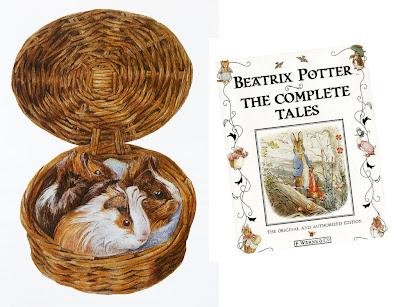 Radikin guessed it right: Today's painting called “Blossomed Furze” was by Beatrix Potter. Most of her famous books, like Peter Rabbit and Benjamin Bunny were based on her own pets by the same name. She carried them around with her on vacations and sketched them often. Throughout her life she made many studies of mushrooms, flowers, animals, birds, landscapes, and interiors, which still set a high standard of observation, even among natural science illustrators.
Radikin guessed it right: Today's painting called “Blossomed Furze” was by Beatrix Potter. Most of her famous books, like Peter Rabbit and Benjamin Bunny were based on her own pets by the same name. She carried them around with her on vacations and sketched them often. Throughout her life she made many studies of mushrooms, flowers, animals, birds, landscapes, and interiors, which still set a high standard of observation, even among natural science illustrators.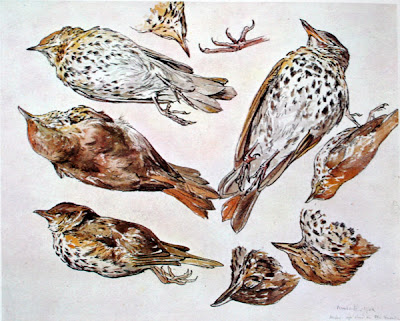 She was a stickler for truth to nature. As much as she adored Wind in the Willows, she once offered this gentle criticism:
She was a stickler for truth to nature. As much as she adored Wind in the Willows, she once offered this gentle criticism:
Kenneth Grahame ought to have been an artist—at least all writers for children ought to have sufficient recognition of what things look like—did he not describe “Toad” as combing his hair? A mistake to fly in the face of nature—a frog may wear galoshes, but I don’t hold with toads having beards or wigs! So I prefer Badger.”
Artwork and quote from The Art of Beatrix Potter, © Frederick Warne Co, 1955.
Blog: Gurney Journey (Login to Add to MyJacketFlap)
JacketFlap tags: Illustrated Books, Preliminary Sketches, Add a tag
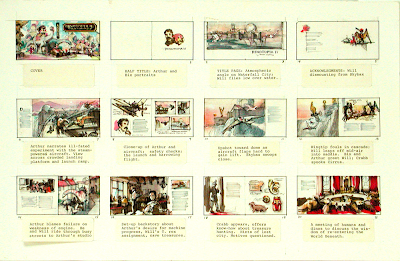 On an earlier post I described my method for doing storyboards in pencil. But for the second Dinotopia book, The World Beneath, I did all the storyboards in marker. I sketched each storyboard panel on bond paper about an inch and a half by three inches.
On an earlier post I described my method for doing storyboards in pencil. But for the second Dinotopia book, The World Beneath, I did all the storyboards in marker. I sketched each storyboard panel on bond paper about an inch and a half by three inches.
I used a hand-held waxer to apply a thin layer of beeswax on the back side of the panels. Waxers have become antique tools; they were used for pasting up elements in old-fashioned layouts. In this way I could reposition the storyboard panels over and over again as the sequences evolved and changed.
The basic story points are typed on pieces of paper below each storyboard panel.
Blog: Gurney Journey (Login to Add to MyJacketFlap)
JacketFlap tags: Writing, Illustrated Books, Add a tag
In a recent post I shared some thoughts about balancing words and pictures in a Dinotopia book. In this followup about the writing process, I’d like to say something about the approach to storytelling.
At one time I thought of a long-form picturebook as a kind of “movie for your hands.” I strove for a tight, three-act dramatic structure to the plot. I read all the books on the theory of writing screenplays for movies. (Below is an unused concept sketch for a 1995 film treatment.)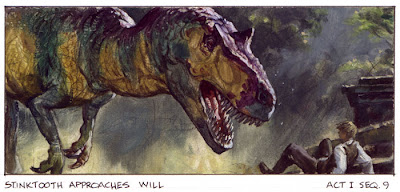 But I’ve gotten away from that way of thinking a bit, because I’m realizing more and more that a picturebook is not like a movie. It’s not ruled by time in the same way as a dramatic presentation. It’s more of a “springboard for daydreaming.” Pictures invite you to hit the pause button on the forward motion of the narrative. You can consider side trips and tangents.
But I’ve gotten away from that way of thinking a bit, because I’m realizing more and more that a picturebook is not like a movie. It’s not ruled by time in the same way as a dramatic presentation. It’s more of a “springboard for daydreaming.” Pictures invite you to hit the pause button on the forward motion of the narrative. You can consider side trips and tangents.
With this in mind, I’ve tried to allow parts of the book, like the whole sequence in Sauropolis, to function a series of episodic diversions and thought experiments before we are grounded again in linear narrative movement.
You could create a full-length picturebook without any overarching story at all, and many masters have. Most of Rien Poortvliet’s books present a loosely connected improvisatory cascade of images. Faeries by Alan Lee and Brian Froud covered the subject topically without an overarching story. So did Arthur Spiderwick's Field Guide by Black and DiTerlizzi. Shaun Tan’s recent masterpiece, The Arrival, has a strong story, but no words at all.
I feel very passionate about extended-length visual books. I’m not even sure what to call the form. It’s not the same as a 32-page children’s picture book (at 160 pages, Dinotopia is five times as long), and it’s not like a graphic novel. Some people have called it a “visual novel” or a “long-form picture book.” But whatever you call it, the words and pictures are inextricably woven, and reinforce each other in all sorts of unexpected ways.
Blog: Gurney Journey (Login to Add to MyJacketFlap)
JacketFlap tags: Illustrated Books, Add a tag
It’s hard for us to imagine the impact that illustrated books had a century ago, before movies and television commanded people’s imaginations. Back then a single new chromolithograph by NC Wyeth or Howard Pyle or Jessie Wilcox Smith was a rare pleasure, like seeing a shooting star or tasting a mango. A book with thirteen color plates was an extravagant feast. Today every time we open our mailbox there’s an avalanche of color pictures.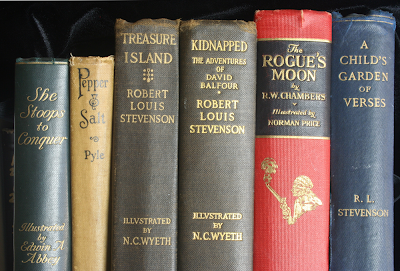 Like everyone else in my generation, I grew up with the TV blasting away in the background. The coffee table was three inches deep in color magazines. But somehow, by some strange magic, those illustrated classics spoke to me from their high shelf. “Take me down, savor me, I will take you to wonderful places,” they seemed to say. Each color plate sent a shiver down my spine.
Like everyone else in my generation, I grew up with the TV blasting away in the background. The coffee table was three inches deep in color magazines. But somehow, by some strange magic, those illustrated classics spoke to me from their high shelf. “Take me down, savor me, I will take you to wonderful places,” they seemed to say. Each color plate sent a shiver down my spine.
Somehow I sensed the rarity and permanence of story illustrations, and I developed a hunger for them. Later, I found a paperback collection of Howard Pyle’s pictures. I bladed it and stuck the pictures all over the house. Those pictures were beacons for my imagination, a kind of steady refuge from the flickering world.
P.S. Sorry for the late post. We've been flying to the west coast today.
Blog: The Places You Will Go (Login to Add to MyJacketFlap)
JacketFlap tags: Authors & Illustrators, Books for Children, Illustrated Books, Illustrated Monday, Add a tag
 I was having a hard time deciding which book to feature on this week's Illustrated Monday until I read a column, in The Horn Book Magazine, about reissues.
I was having a hard time deciding which book to feature on this week's Illustrated Monday until I read a column, in The Horn Book Magazine, about reissues.
Apparently, new versions of Laura Ingalls Wilder's Little House books do not contain Garth Williams's drawings. Neither does his art appear on the covers. Instead, photographs are used.
Also, it seems that you have to pay US$2 more if you want the versions in which Williams' illustrations appear. However, you don't get the original black-and-white pictures: they've all been colourised, which some may prefer. I don't!
A five-in-one book called A Little House Collection (below, left) has also been released. It comprises the first five Little House books (Little House in the Big Woods, Little House On the Prairie, On the Banks of Plum Creek, By the Shores of Silver Lake and The Long Winter). I have no idea why they didn't include Little Town on the Prairie and These Happy Golden Years.
Says the columnist Terri Schmitz, "At 618 pages, with a whopping forty-dollar price tag, A Little House Collection is almost impossible to handle, and in order to accommodate all of the text every page is divided into two columns,  with the art squeezed in willy-nilly. It's a shameful and unnecessary way to treat Mrs Wilder, whose books have given so much pleasure to so many children over the years. Her books deserve better than being reduced into a doorstop." Hear hear!
with the art squeezed in willy-nilly. It's a shameful and unnecessary way to treat Mrs Wilder, whose books have given so much pleasure to so many children over the years. Her books deserve better than being reduced into a doorstop." Hear hear!
Anyway, after all that, this week's featured illustrations are by Garth Williams and from the Little House books.
 I went to the HarperCollins website to have a look at those new Little House books. Well, what do you think? I say, "TACKY!"
I went to the HarperCollins website to have a look at those new Little House books. Well, what do you think? I say, "TACKY!"
The following illustrations are from the Puffin editions of Laura Ingalls Wilder's Little House series, illustrated by Garth Williams (click on the thumbnails for bigger versions of the pictures):
 from Dance at Granpa's, pg 88 in Little House in the Big Woods
from Dance at Granpa's, pg 88 in Little House in the Big Woods
 from The House on the Prairie, pg 50 in Little House on the Prairie
from The House on the Prairie, pg 50 in Little House on the Prairie
 from Runaway, pg 55 in On the Banks of Plum Creek
from Runaway, pg 55 in On the Banks of Plum Creek
 from Merry Christmas, pg 144 in By the Shores of Silver Lake
from Merry Christmas, pg 144 in By the Shores of Silver Lake
 from Three Days' Blizzard, pg 81 in The Long Winter (that's Almanzo Wilder frying pancakes. Laura marries him in These Happy Golden Years)
from Three Days' Blizzard, pg 81 in The Long Winter (that's Almanzo Wilder frying pancakes. Laura marries him in These Happy Golden Years)
 from Working in Town, pg 26 in Little Town on the Prairie
from Working in Town, pg 26 in Little Town on the Prairie
 from First Day of School, pg 20 in These Happy Golden Years
from First Day of School, pg 20 in These Happy Golden Years
Blog: The Places You Will Go (Login to Add to MyJacketFlap)
JacketFlap tags: Young Adult Novels, Reading Room, Illustrated Books, Add a tag
Five YA novels and a picture book are what's featured this week on Junior Reading Room. Cut out the coupon to enjoy a 20% discount at Kinokuniya Books.
Fragile Jade
 |
Author: Deb Caletti
Publisher: Simon & Schuster Children’s Publishing, 304 pages
UNLIKE the substance she’s named after, Jade isn’t “stronger than steel”. The 18-year-old suffers from panic attacks and, in an attempt to calm herself, she volunteers at the zoo and is assigned to work with the elephants.
Jade has another reason for wanting the job: Sebastian, the cute boy whom she had been “spying on” via the zoo’s webcam. As fate would have it, Jade and Sebastian meet and fall in love. However, he has a secret that threatens to destroy Jade’s hopes and dreams. Will she be strong enough to face the truth?
 |
Author: Dana Reinhardt
Publisher: Wendy Lamb Books, 240 pages
MARIAH, Anna, and Emma tell their parents that they’re going to the movies but instead, visit a boy from school. When the adults turn up at the cinema, it looks like the girls are going to get busted and so they continue lying to avoid punishment.
They tell their parents that they were attacked by a stranger on their way to the movies, but what the friends don’t count on is for their fib to completely overtake their lives. Their parents make a police report, everyone at school labels them “heroes” and a man is actually arrested for the imagined crime.
Each passing day leaves the girls feeling bad about their lie, but will their guilty conscience be enough to persuade them to come clean?
 |
Un Lun Dun
Author: China Mieville
Publisher: Del Rey Books, 448 pages
DEEBA and Zanna discover a wheel that, when turned, makes London disappear! The pair then find themselves in UnLondon, an alternate world where the debris of the London they know end up!
UnLondon is threatened by Smog, a poisonous cloud, which the girls try to destroy with the help of a talking magic book, and the most remarkable group of UnLondoners!
This is an exciting and imaginative tome packed with surprises that will keep its readers in a state of constant delight, wonder and suspense.
Ambergate
Author: Patricia Elliott
Publisher: Little, Brown Young Readers, 400 pages
 |
Instead, Scuff, Murkmere Hall’s lonely and ill-used kitchen maid, is at the centre of this story. An orphan, Scuff has a dark secret that she fears would, if revealed, cost her her life.
On hearing that she is being pursued by soldiers, she flees Murkmere, but for just how long and how far will she be able to avoid capture and the truth?
Treasure Fleet: China Discovers the World
Author: Ann Bowler
Ilustrator: Lak-khee Tay-Audouard
Publisher: Tuttle Publishing, 32 pages
 |
The book is packed with beautiful illustrations and interesting facts although some may find the layout a little too “busy”, with the text packed too tight on each page.
The Opposite of Music
Author: Janet Ruth Young
Publisher: Atheneum Books, 352 pages
 |
It’s up to Billy and the rest of the family to help him, but, after a time, the strain of caring for Dad starts to become too much for everyone. Who will care for the carers?
This painfully-honest novel explores the often-overlooked problems faced by those who devote their lives to caring for sick friends or relatives.
Add a CommentBlog: The Places You Will Go (Login to Add to MyJacketFlap)
JacketFlap tags: Tots to Teens, Authors & Illustrators, Books for Children, Illustrated Books, Add a tag
Here are some of my favourite illustrated children's books. It would take too much space and time to list them all, but I will keep adding to the list.
1. Ballet Shoes by Noel Streatfeild
Illustrated by Ruth Jervis who, coincidentally, was Streatfeild's sister. When she was hired, Streatfeild's publisher had no idea of her connection to the author.
2. The Candlemas Mystery by Ruth M. Arthur
Illustrated by Margery Gill
3. Dido and Pa by Joan Aiken
Illustrated by Pat Marriott
4. Another Lucky Dip by Ruth Ainswroth
Illustrated by Shirley Hughes
5. Winter Holiday by Arthur Ransome
Illustrated by Arthur Ransome
6. The Gardens of Dorr by Paul Biegel
Illustrated by Eva-Johanna Rubin
7. Uncle Cleans Up by J. P. Martin
Illustrated by Quentin Blake
8. Minnow on the Say by Philppa Pearce
Illustrated by Edward Ardizzone
9. The Edge of the Cloud by K. M. Peyton
Illustrated by Victor G. Ambrus
10. The Glass Slipper by Eleanor Farjeon
Illustrated by Ernest H. Shepard
11. The Adventures of Chunky by Leila Berg
Illustrated by George Downs
12. Little House in the Big Woods by Laura Ingalls Wilder
Illustrated by Garth Williams
13. The Little Book Room by Eleanor Farjeon
Illustrated by Edward Ardizone
14. The Glassblower's Children by Maria Gripe
Illustrated by Harald Gripe
 An illustration from The Glassblower's Children.
An illustration from The Glassblower's Children.
18 March 2007, Star Mag Illuminating illustrations
I’M happy to see some really nicely illustrated, newly published
children’s books in the stores. I don’t mean picture books, which,
obviously, have to be illustrated, but storybooks, what the Americans
call chapter books.
Once upon a time, most storybooks were illustrated. If you’re in your
30s or 40s (and older) you may remember wonderful books published by
Puffin (always edited by Kay Webb) with black and white drawings.
Probably the most famous illustrated children’s storybooks are Lewis Carroll’s Alice’s Adventures in Wonderland and Through the Looking Glass and A.A. Milne’s Winnie the Pooh and The House at Pooh Corner.
When I spoke to writer/illustrator John Burningham a few years ago, he
said that the main reason storybooks are no longer illustrated is
because it adds to the cost of production (in terms of printing and
having to pay the illustrator).
He also thought that, somewhere along the line, publishers decided that
children, having made the transition from picture books with minimal
text to full-length books, no longer needed their stories illustrated.
Shirley Hughes, an award-winning illustrator who has worked on both picture books and storybooks, says, in her autobiography, A Life Drawing,
“It is sad that the black and white illustrations once so common in
books for older children are now often cut out and the jump from
full-colour picture books to an unventilated page of solid text is such
an abrupt one. “We are depriving the child reader of the
intense pleasure of opening books, even penalising them for having
mastered the magic skill of reading”.
Is there anyone who doesn’t love looking at beautiful pictures? I think
even adults would welcome illustrations in the books they read. A
picture is sometimes what is needed to unlock the magic of a book,
pique the reader’s interest, prod his imagination into action, as it
were.
Mervyn Peake’s Gormeghast trilogy features a few black and white line
drawings (by the author) that are, to say the least, intriguing. And
one of the reasons I loved Reader’s Digest Condensed
Books was because they were illustrated. I would pore over the pictures
when I was little. The stories didn’t interest me until much, much
later. When people complain about wanting to be left alone with
their own ideas of what characters and scenes are like, my response is,
“So you’re saying you have a limited imagination?” This usually leads
to an argument, sometimes rather heated.
Some say the presence of illustrations interfere with the pictures that
pop into their heads when they read a book. They are annoyed when the
artist’s portrayal of a character doesn’t match the author’s
description. Actually, I understand how they feel as that is my
response to movie adaptations of novels.
But somehow, to me, a static drawing, no matter how lively in feel,
never intrudes on one’s imagination in quite the same way as a walking,
talking actor does (ie, Gwyneth Paltrow in Emma and Possession).
Illustrations simply capture moments and interpret emotions. I like to
think of them as reflections of the author’s words. They do not consume
and assume his ideas like bad acting or a miscast actor can.
The next time you’re in a second-hand bookshop, look out for children’s
storybooks published in the 1970s and earlier. Browse through them so
you can choose the ones with illustrations. And look out for
illustrators like Pat Marriott, Shirley Hughes, Peggy Fortnum, Margery
Gill, Garth Williams and Edward Ardizzone.
If you’re shopping for new books, check out The Mysterious Benedict Society (by Trenton Lee Stewart, ISBN: 978-031-605-7776), The Invention of Hugo Cabret (by Brian Selznick, ISBN: 978-043-981-3785), The Valley of Secrets (by Charmian Hussey, ISBN: 978-068-987-8626) and The Seven Wonders of Sassafras Springs (by Betty G. Birney, ISBN: 978-141-693-4899).
They are just some of the beautifully and imaginatively illustrated
children’s books that are now available. Perhaps publishers are
beginning to realise that most people are never too old or serious for
pictures.



These are great! Yes, please post more. I love your blog.
OMG ! Put that book online !!!
Or better, create a whole new blog : "Where Great Literature and Art meet..."
I'm currently into bookcovers myself. You've given me a great idea !
(but I don't know what a 'manuscript' is...
is that like a PDF...but like a century ago ?)
Ha! That's really funny/bizarre, I love it. I've done one bvook cover so far and it's been my biggest disaster too. I'm still running from it.So much pressure wrapped up in one picture.
haha, hilarious,
and man am i jealous about the other artists you get to hang out, do they all were tron goggles too while you talk about the magic of there art, haah!
i would love to see more from this book too, your illistration looks like somthing from mad magaizine, awsome!
Haahaha...oh man that's so great.
I love the title, the hand-lettering gives it such gravitas that you'd think it was a primer on art for the uninitiated.
Out here in Seattle there's a sign that changes quotes and this weeks states: "There are no parks with statues dedicated to committees."
I miss hanging out sketching with my pals...thanks for reminding me to get out of the studio. We lead such insular lives!
=s=
I love illustrating excerpts! I wish I had friends who were artists that I could hang out with. That would be a great way to avoid doing homework. However, there are no illustrators nearby because I'm in a very evil institution that does not like illustration. Alas...
More! More!
(why be elaborate when succint and to-the-point works just as well)
It would be quite awesome if you could offer one of these as a weekly inspiration to us sketch-happy blog followers. I get the feeling many of us would love to give back a bit in this job, but on the other hand, you do spend a lot of valuable time with this blog already, and we don't want to go getting greedy. It's a great idea, makes me remember my school days in biology, where I was constantly poking fun with sketches at something the teacher or our text books said.
OK, Jen. Let's try it. Check out today's post.
Oh that looks fun! I like what they did -- oh now I don't feel bad at all for what I sent in for the Sketchblog Challenge! How neat!
So this is what started it. I love the gold lettering you did on that sketchbook too, it's gorgeous. Wish I lived near enough to you to contribute a page, but maybe you can print out what I send when you do these challenges.
Robert